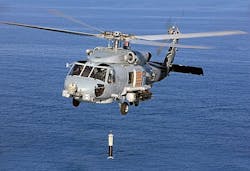Navy asks industry for new cable to improve deficiencies in AN/AQS-22 helicopter dipping sonar
Officials of the Naval Air Systems Command at Patuxent River Naval Air Station, Md. released a solicitation last week (N00019-15-R-0001) for the AN/AQS-22 Airborne Low Frequency Sonar (ALFS) Improved Sonar Cable for the MH-60 Romeo program.
The solicitation asks companies qualified to design and produce high-reliability sonar cable for the AN/AQS-22 ALFS dipping sonar to bid a new cable job that improves on the existing cable's drawbacks that include uncertain shelf life; cable miswraps on the reeling machine; cable jacket stretching or deformation that changes the cable's reeling characteristics; and an inability of the ALFS cable position sensors to detect the cable's white marks.
Related: New ship takes lead in countermine and anti-submarine warfare
The solicitation includes the requirements for non-recurring, delivery of cables for testing, and Options for the procurement of cables for retrofit.
(story continues below)
Navy experts want to integrate the new cable in the existing AN/AQS-22 ALFS system as a replacement for the existing sonar cable. The new cable should meet or exceed the current sonar cable's performance and meets Navy performance requirements.
The AN/AQS-22 dipping sonar is the primary undersea warfare sensor of the MH-60R multi-mission helicopter. It enables the MH-60R to detect, track, pinpoint, and classify potentially hostile submarines. It reels the sonar transducer from the aircraft and can operate the sonar at a wide variety of depths to find submarines hiding under temperature inversions in the water.
The current ALFS sonar cable on the Navy Sikorsky MH-60R ASW helicopter has an estimated life of as long as six years, including one year in storage prior to first use, yet some things have cropped up that reduce the cable's life and increase the risk of the cable breaking and losing the transducer assembly part of the sonar during dipping operations, Navy officials explain.
The project has two parts: non-recurring engineering and candidate cable delivery; and recurring cable production. The first phase may involve several contractors and three candidate cables. The second phase will choose one cable for production.
Companies interested may view documents outlining the solicitation, statement of work, and performance requirements online at www.navair.navy.mil/index.cfm?fuseaction=home.solicitation_view&Sol_No=N00019-15-R-0001.
Related: ASW and surface warfare technology upgrades move to fleet
Companies that would like to submit bids for the new dipping sonar cable should respond no later than 30 Jan. 2015 by post or courier to Naval Air Systems Command, Code: AIR-2.3.4.2.7 (Ms. Erika Griffin), 47123 Buse Road, Bldg. 2272, Room 155, Patuxent River, MD 20670, Solicitation Number: N00019-15-R-0001.
For questions or concerns contact the Navy's Erika-Lynn Griffin by email at [email protected], or by phone at 301-757-5398. Also contact the Navy's Erin Bailey by email at [email protected], or by phone at 301-757-8970.
More information is online at https://www.fbo.gov/spg/DON/NAVAIR/N00019/N00019-15-R-0001/listing.html.
